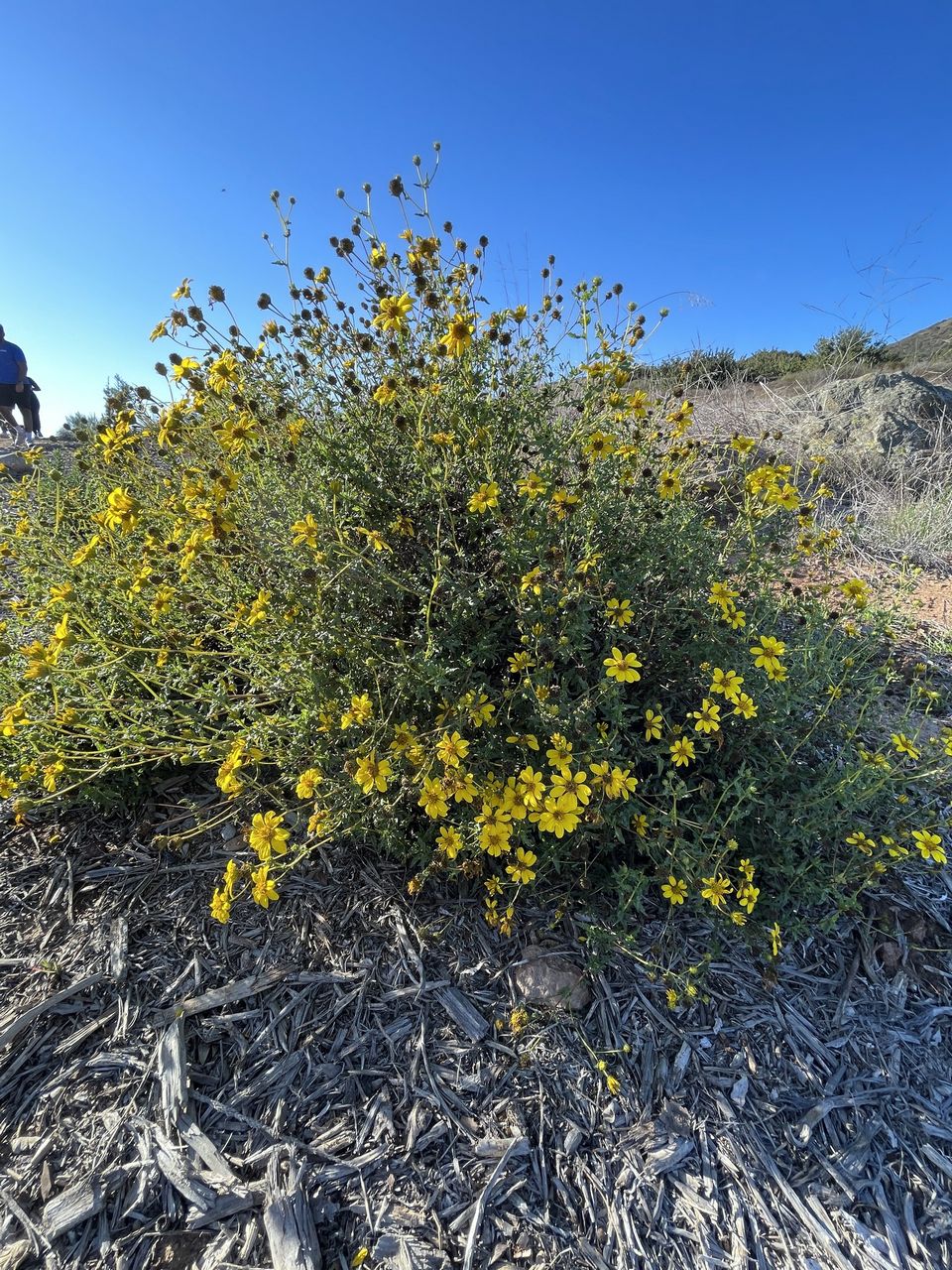Bahiopsis laciniata 11821
Author: (Asa Gray (1810-1888)) Edward E. Schilling (1953-) & José L. Panero (1959-)Family: Asteraceae Subfamily: Asteroideae Tribe: Heliantheae Subtribe: Helianthinae
Genus: Bahiopsis
Synonym(s): Viguiera laciniata
English name: San Diego County sunflower
Zone: California
Description
This species is restricted to coastal southern California and northern Baja. It is native to the dry mesas, canyons and mountain slopes as part of chaparral and coastal sage scrub.

Bahiopsis laciniata Observed in United States of America by E. Merkt (license)
Botanical Description
This is a shrub, 50-130cm.
The leaves are mostly alternate. The petioles are 3-7mm. The blades are lanceolate to lance-ovate, 1.4-4.3 x 0.6-2.5cm, margins laciniate, faces sparsely strigillose and gland-dotted or resinous (abaxial resinous, shiny).
There are 3-9 flowerheads. The peduncles are 0.5-5cm. The involucres are hemispheric, 8-12 x 6-9mm. It has 20-25 phyllaries, 4-8 x 1.8-2.2mm. The paleae are lance-ovate, 4.5-7.3mm (densely glandular). There are 5-13 ray florets. The laminae are 6-12mm. It has 50 or more disc florets. The corollas are 3.5-4.6mm.
The cypselae are 1.7-3.5mm (strigose, margins ciliolate). The pappi are of 2 lacerate, aristate scales 1-2.5mm plus 2-6 (easily detached) lacerate-erose scales 0.2-0.5mm.
References
- Calscape. Bahiopsis laciniata
- eFloras. eFloras.org Vol. 1 pag. 250066199. Bahiopsis laciniata
- The Jepson Manual, Jepson, Willis Linn. 1993. ISBN
The leaves are mostly alternate. The petioles are 3-7mm. The blades are lanceolate to lance-ovate, 1.4-4.3 x 0.6-2.5cm, margins laciniate, faces sparsely strigillose and gland-dotted or resinous (abaxial resinous, shiny).
There are 3-9 flowerheads. The peduncles are 0.5-5cm. The involucres are hemispheric, 8-12 x 6-9mm. It has 20-25 phyllaries, 4-8 x 1.8-2.2mm. The paleae are lance-ovate, 4.5-7.3mm (densely glandular). There are 5-13 ray florets. The laminae are 6-12mm. It has 50 or more disc florets. The corollas are 3.5-4.6mm.
The cypselae are 1.7-3.5mm (strigose, margins ciliolate). The pappi are of 2 lacerate, aristate scales 1-2.5mm plus 2-6 (easily detached) lacerate-erose scales 0.2-0.5mm.
References
- Calscape. Bahiopsis laciniata
- eFloras. eFloras.org Vol. 1 pag. 250066199. Bahiopsis laciniata
- The Jepson Manual, Jepson, Willis Linn. 1993. ISBN
References for the genus
- eFloras. eFloras.org Vol. 1 pag. 103365. Bahiopsis
General specifications
Biological type: plant
Frost resistance: 19ºF
Leaf color: dark green
Flower color: yellow
Specifications for the Mediterranean basin
Adult size (h x w): 2,9ft x 1,6ft
Sun exposure: full sun (Sun hours: >6h Foliage: evergreen
Growth: fast
Flowering time from April until August
Specific information for our garden
Planting substrate: 30%Compost+30%Coco+40%Sand
Plant watering: 1x a week pH 6.5
Logical sequence of containers for: Perennials; forestry plate 8cm, 1L container, 2L forestry pot, 6L container, 55L container
Propagation is done by root division
Ecology in its country of origin
Rainfall: 200-400mm
Gravelly soil: much
Sandy soil: much
Frost resistance: 19ºF
Leaf color: dark green
Flower color: yellow
Specifications for the Mediterranean basin
Adult size (h x w): 2,9ft x 1,6ft
Sun exposure: full sun (Sun hours: >6h Foliage: evergreen
Growth: fast
Flowering time from April until August
Specific information for our garden
Planting substrate: 30%Compost+30%Coco+40%Sand
Plant watering: 1x a week pH 6.5
Logical sequence of containers for: Perennials; forestry plate 8cm, 1L container, 2L forestry pot, 6L container, 55L container
Propagation is done by root division
Ecology in its country of origin
Rainfall: 200-400mm
Gravelly soil: much
Sandy soil: much
Sowing instructions
SPRING Sow the seeds at 2mm depth in the Well Drained Seed Sowing Mix between 68-77°F. During germination keep the substrate moist and in daylight.
The average seed weight is 1351,4 per gram (0,00074g).
Germination references
- Role of fire in seed germination of woody taxa in California Chaparral, Keeley Jon E. Ecology 1987 Vol. 68(2) pag. 434-443. DOI
The average seed weight is 1351,4 per gram (0,00074g).
Germination references
- Role of fire in seed germination of woody taxa in California Chaparral, Keeley Jon E. Ecology 1987 Vol. 68(2) pag. 434-443. DOI
Experiences in the garden
07-03-23A Obtaining seeds from seed provider Libertos.
27-03-24 Sown 60 seeds in a seed plate ½, they did not geminate in Serre5.
Protocol: Spring Soak 68°F 12h 2mm Sowing mix+Sand 64-72°F Damp substrate+Light
06-12-24B Obtaining seeds from seed provider Libertos. Stock
06-05-25 Sown 20 seeds in a seed plate ½ and germinated at 16-06-25, result: 4 units in Serre11.
Protocol: Spring 2mm Sowing mix+Sand 68-77°F Damp substrate+Light